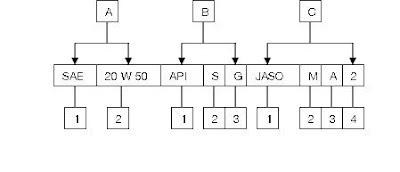Off late there have been quite a few doubts, questions & debates on the make, grade & type of oils to be used on Motorcycles.
This is an effort to de-mystify the misconceptions many have with respect to Engine oils.
Typical oil:
Oils are classified under the SAE standard & the other micro level standards

A: SAE 20 W 50
A1 : The Grading of Oils is done under " Saybolt system" a Standard set by SAE(Society of Automotive Engineers) for deriving at the Oil grade ie SAE 20 W 40 or 10W30 etc.
A2 : The number 20W tells about the winter grade rating ie at 0oC & Sub 0o C, the oil would have the flow ability & property equivalent to that of a 20 grade oil(thin) . This goes to tell us subtle that the Clearance (Cold) of moving parts like bearings, Cyl blk & piston etc can be kept low. These low clearance parts can be lubricated well even in cold condition. This number helps in cold by lubricating it better & we’d have less noisy start. This also means that the wear & tear of the internal parts of the Engine are very much reduced.
As the oil temp increases, its properties gradually change. Though the oil looks & feels thinner, the reversible change in property tends to make the oil behave like a thicker grade which is equivalent to the higher grade (number) noted at the end of the grading oil. At optimum temp of the oil, it would have the properties of 50 grade oil (Thicker). This takes care of lubrication at higher temperatures. It is now clear about the first two digits along with the alphabet "W" stands for the winter grade Or when the oil temp is cold & the next stands for the summer grade or when the oil temp is hot.
B: API SG
B1 : Further classification of the type of service types an oil can perform is done by API (American Petroleum Institute)
B2 & B3: In the alphabets ‘SC, SD,’ etc… The 'S' stands for 'spark' ignition engines, which are petrol engines. SE, SF, SG, SH, SJ etc, indicate progressively better grade oils. Now we do have even 'SJ' classification oils available in the country.
The 'C' classifications of the API are for 'compression' ignition engines, i.e. Diesel engines. These are available as 'CC - CG' grades, and get progressively better and obviously - expensive as we go up the scale.
There are quite a few oils which can be used on both Petrol as well as Diesel engines, though they may not be equally good for both the engines. Few may be marked as 'API-SG/CD'. So that indicates that though the oil is really good for Petrol, but will work only equivalent to a 'CD' rated oil if put in a Diesel engine, which is ok to use in older technology Diesel engines. Some marked as 'API - CF/SD' rating more so meant for Turbocharged Diesel engines & will work only as good as an 'SD' rated oil in a petrol engine. Today Bajaj Engines demand nothing less than 'SG' rating or higher in the API classification.
Just the 'SH' or ‘SG’ or ‘SJ’ would only help reduce friction in the engine, but on contrary on a motorcycle with common clutch & gear box, the clutch plates are in for a higher degree of wear.
This goes to say that a particular Service type of Oil will provide protection against wear, corrosion & deposits resulting from short trip, start & stop run & other things & also work towards reduction of abnormal deposits & sludge formation which may be hastened during high temp high speed runs. But not necessarily increase the wear resistance in the clutch
Typical car engine oil is classified up until the API classification.
C: JASO MA 2
C1: Ever Since the Car engine oils started to tend towards lower resistance to friction, the same started to increase the wear on clutch plates & also cause pitting of gears in motorcycles which shared common oil between Engine, Clutch & gear box.
JASO: Japanese Automotive Standards Organisation (A wing of Japanese - Society of Automotive Engineers [J-SAE]) Along with JAMA (Japanese Automotive Manufacturer’s Association) went on to define a test standard for Oils which could be used on motorcycles using common oil every where. This test ensures protection to clutch & gear box along with that of the engine
C2: The Alphabet ‘M’ stands for Motorcycle type application
C3 & C4: In the classification MA, the Alphabet ‘A’ stands for Frictional application type, which means it is suitable for use on motorcycles which share common oil between Engine, Gear box & Clutch. As the DFI (Dynamic Frictional Index), SFI (Static Frictional Index) & STI (Stop Time Index) get better, the Type application index number Raises from MA to MA1 & still higher to MA2.
If it is classified as MB, ‘B’ in this case is Non Frictional application, suitable for Engine which has a separate clutch & gear box.
Since the Manufacturers know their bike best, the right Grade & type classification of the oil best suited for their bike, would be suggested after a series of tests & study of wear patterns. This will enhance the life & performance of the engine. It is suggested to look for the service type along with grade, before we buy oils. Ensure the Manufacturers requirement before the purchase. This is the safest way to ensure long life & great performance of your machine. I hope this makes things clear as far as the Grade & Service type of oils are concerned.
Compiled from the following Sources:
1. http://bajajpulsar.org/archive/bajajpulsar_msgs_2000_to_3000.mbx/0209.html
2. http://bajajpulsar.org/archive/bajajpulsar_msgs_2000_to_3000.mbx/0223.html
3. JASO T-903: 2006 Motorcycle Oil Std testing procedure.
4. Special thanks to my old friend Mr. Rajeev Singh, Special Officer at UNDP Office, New Delhi.
Compiled & edited by
Venkat Shyam,BV
Auto Service
Bangalore
E-mail: v.v.shyam@gmail.com
(C) Venkat Shyam
